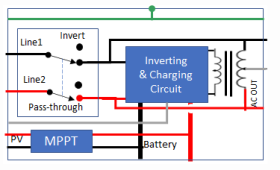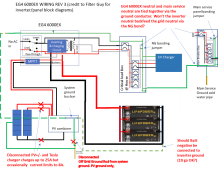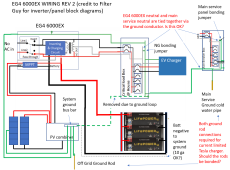Hi Summit,
Thanks for the feedback and reference posts. Here's my wiring diagram below. My Tesla charger started faulting again, so I tried disconnecting the PV+/- per your suggestion, and the Tesla charger faults went away (most of the time)! I cranked up the Tesla charger to 25A and it ran for a few minutes and then faulted and current limited to 8A again. Weird thing is that it seems to have recovered and is charging at 15A now.
While I'm happy that this allows me to charge at >8A, I guess this means I can only charge from battery while the PV+/- is disconnected. That disconnect switch is going to get a lot of wear and tear!
Questions:
1. Even stranger, the charger cycles between 15A and 22A on its own! Did you see that behavior with your charger?
2. After removing your non-operating grid tie inverter, did the 280 kohm resistance between PV(-) and ground change?
3. Are you using AC in and did you have to bond your EV charger subpanel to neutral/ground to get the charger to work? Since my charger only works when using my main service panel ground, I'm still concerned that some of my inverter neutral current could be backfeeding the grid neutral via the main service panel NG bond. Any thoughts on that? Note that I'm fully off-grid (no AC in), so although it appears that I have a double NG bond (critical loads panel and main service panel each have a NG bond), I think that's OK since I'm not using AC in.
4. Did you tie your battery ground to your inverter ground to establish a system ground? In that case the system ground is then tied to earth ground.
Sorry for all the questions. Would appreciate anyone else chiming in as well.
View attachment 130559







